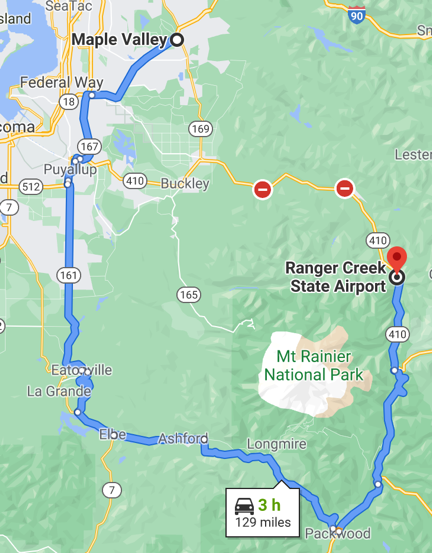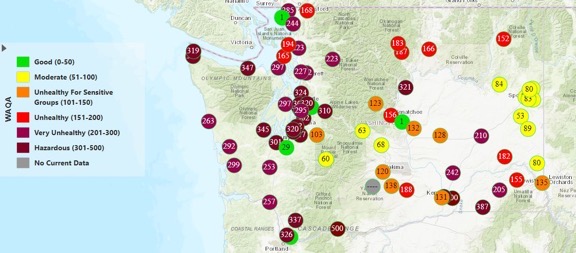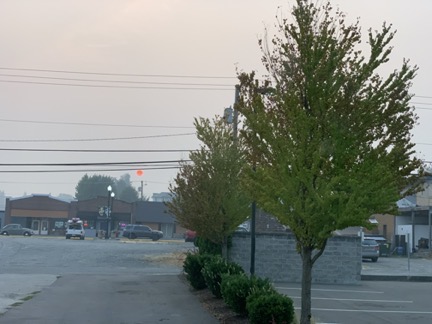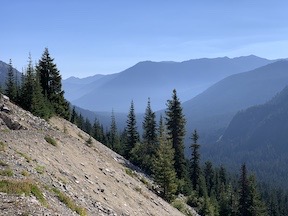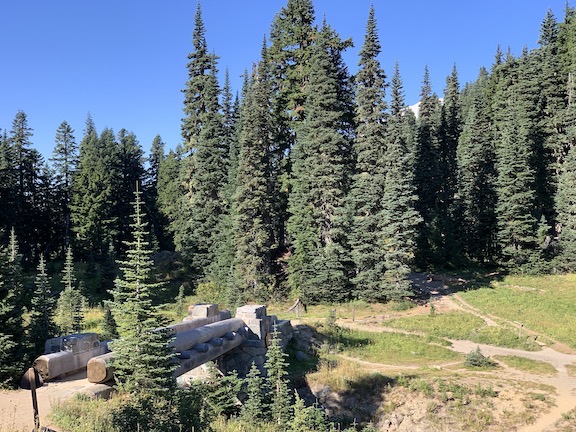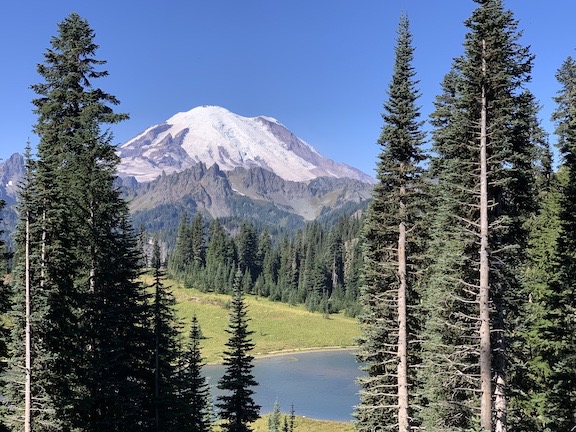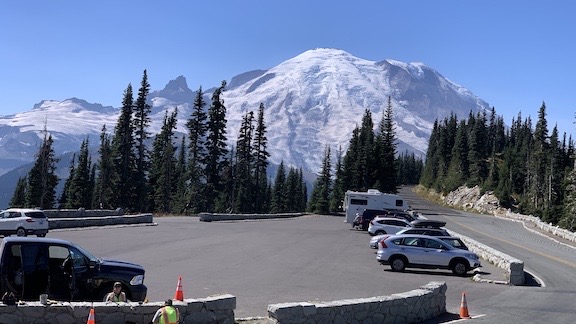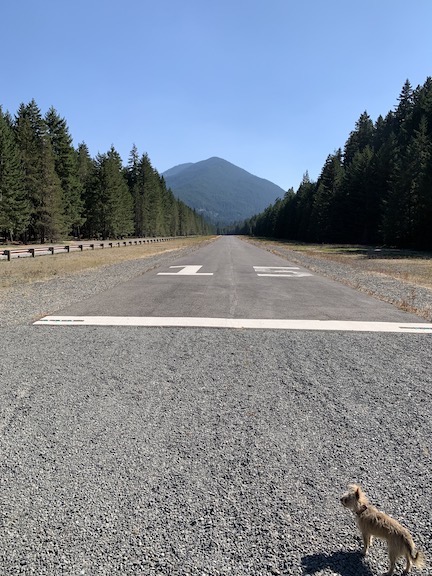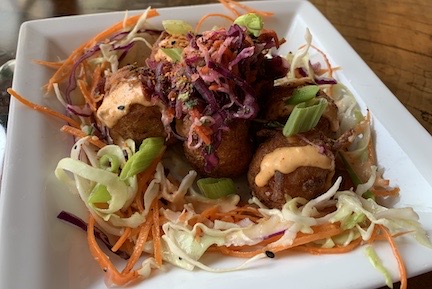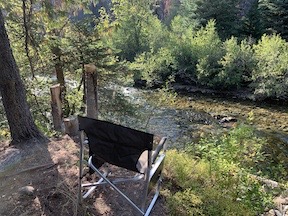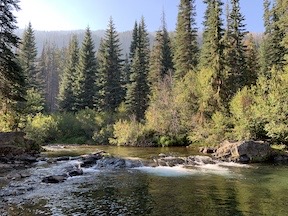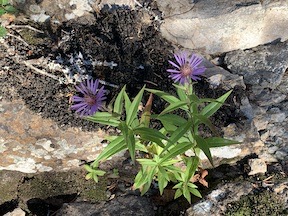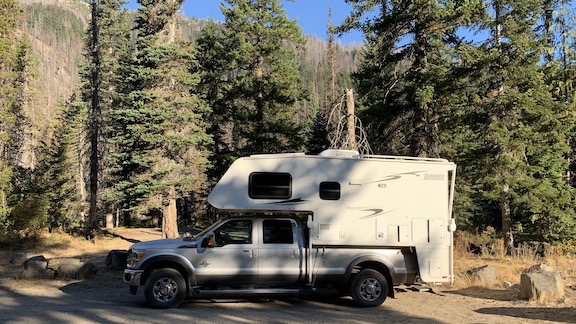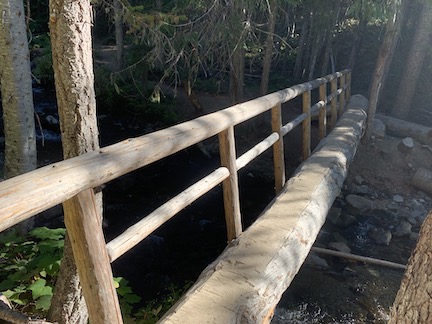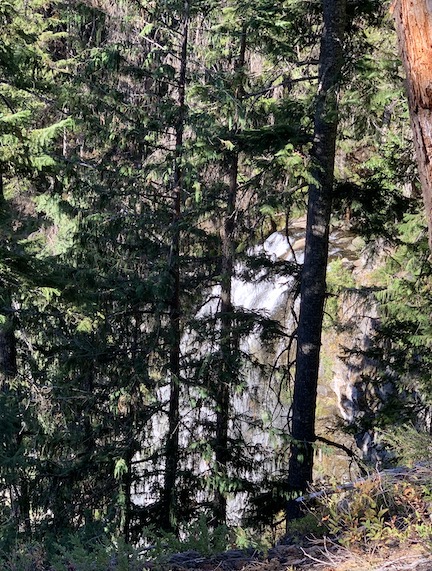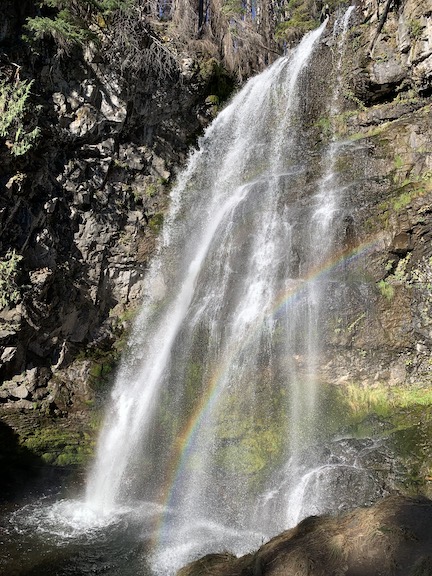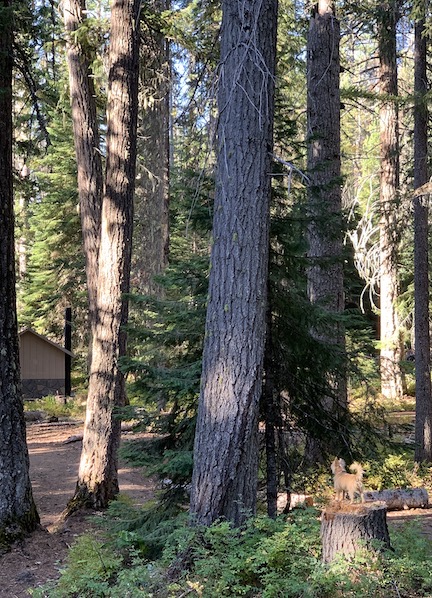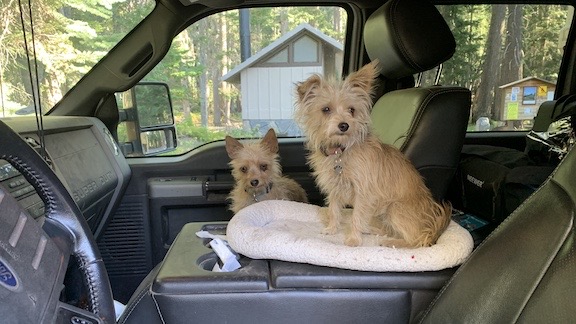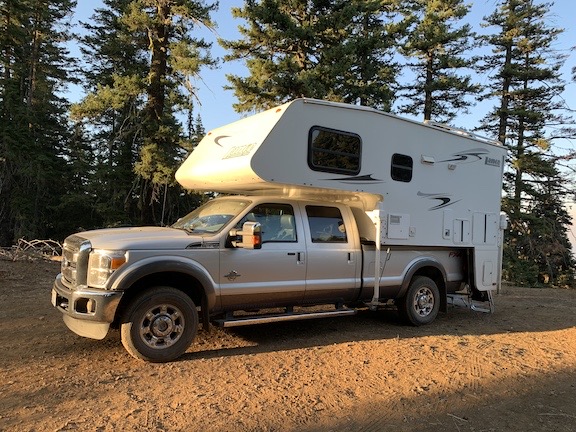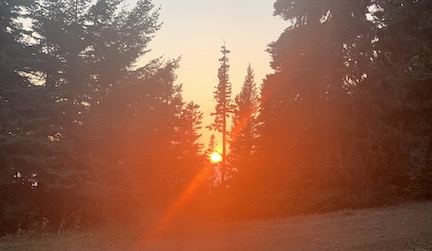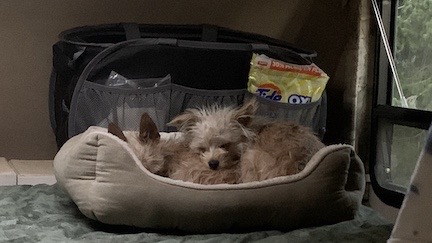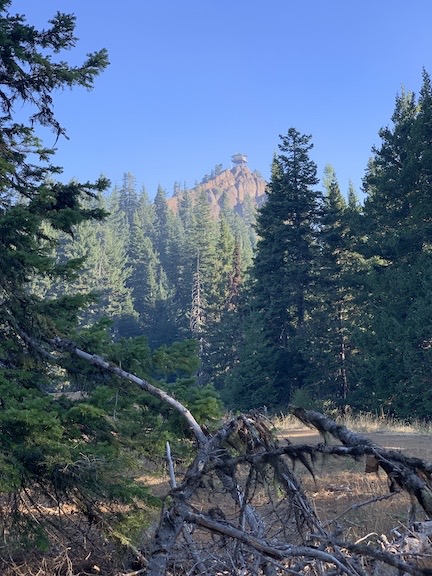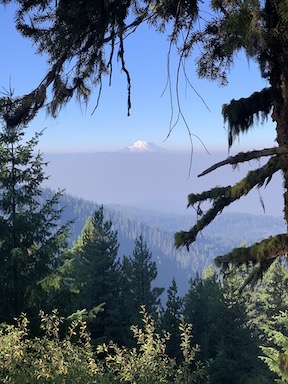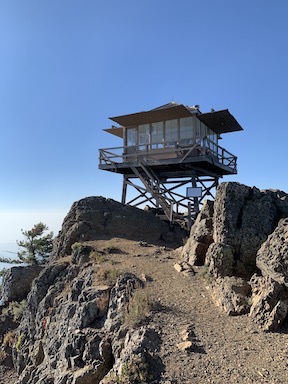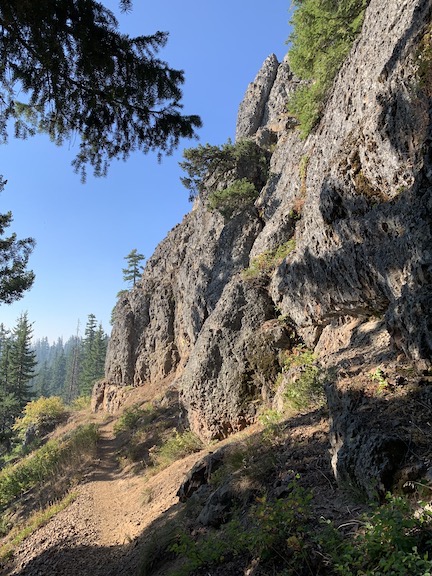I spend two nights in a pleasant campground, recovering from a weekend of hard work and bad air.
• Red Top Lookout
• American River Campsite
• Mt Rainier and the Buck Creek Campsite
• A Driving Day with a Crappy Campsite
• The Blacksmithing Weekend
• Dungeness Recreation Area
Last year, I spent a weekend in Port Angeles, WA, on the Olympic Peninsula, selling my jewelry — or at least trying to — at a rock show there. I had done very well in January at a rock show in Mesa, AZ, and figured that might just be my niche. It wasn’t. I barely made enough to make the trip all the way out there worthwhile.
While I was at the show, I camped out in a corner of the municipal parking lot. It was surprisingly pleasant — heck, deer came out of the woods right there to nibble on the blackberries that grew beside the spaces — but I knew damn well that I’d be overstaying my welcome if I spent the night after the show there. So I whipped out my public lands campground app, Ultimate CG, and found Dungeness Recreation Area, a county park just down the road in Sequim.
It was raining gently when I arrived just before dark and I found a campsite in one of the loops. It was surprisingly large and private, as were most of the other sites. Very pleasant. And I had the added bonus of finding a few very healthy lobster mushrooms at the back of my site in the woods.
Settling in at Dungeness
All that was on my mind when I left Eatonville and headed west. It was a 2-1/2 hour drive and I arrived at least a half hour after dark. With those lobster mushrooms in my mind, I tried to remember what site I’d been in. I wound up in the site right next to it.

Here’s a photo I shot in the morning of my truck backed into our campsite. There was lots of privacy with dense vegetation on either side of us.
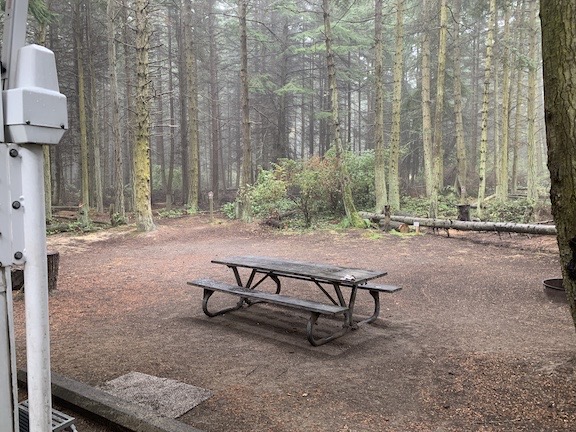
The campsite was spacious with a picnic table, fire pit (just out of the shot), and enough space to erect multiple tents. Because there was no campsite behind ours, we had the illusion of woods going on forever.
I was dead tired and tightly wound when I backed into the spot, using a lantern as a parking guide. It was darker than I thought possible for a county campground. I absolutely hate driving at night in an unfamiliar area and the last 45 minutes had been stressful for me. I was glad to get in. I had just enough energy left to take the girls for a quick business walk, make us all dinner, and then take one more short walk for good luck. I had the pay envelope, but it didn’t give a rate anywhere on it and I certainly wasn’t going to walk all the way back to the pay station in complete darkness anyway. I’d pay in the morning.
I slept surprisingly well. Well, maybe not so surprising when I think about how tired I was. I made my coffee while the girls were still asleep and managed to finish half of it before they woke up. Then it was time to take them for a walk.
And that was the drawback of staying at a real campground: I couldn’t just open the door and let them out to pee. I had to put them on leashes and take them for a walk.
I got dressed, grabbed the campground registration form I’d filled out the night before, put some money in my pocket, and leashed up the girls. Then we set out toward the pay station.
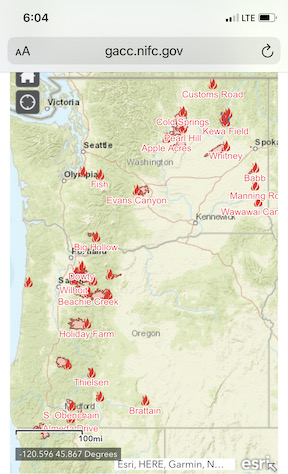
There were fires burning throughout Washington, Oregon, and California (not shown on this map). The smoke in the west had become “hazardous.”
It was a pleasant walk despite the foglike smoke that had settled over the area. Visibility couldn’t have been more than a half mile, but since we were walking in the damp forest, it didn’t really matter. We cut through the campground on a path I’d remembered from the previous year. The girls sniffed and did their business along the way.
At the pay station, I put $26 in the envelope and noted the 12 noon checkout time. I grabbed a park map and we headed back to the camper. I finished my coffee and made us all breakfast.
Full Day at Dungeness
The plan that day was to hike out on a path along the ocean known as “the Spit.” There was a lighthouse at the end that I’d never seen. So after breakfast I packed up a small daypack with rain gear — there was rain in the forecast — bottled water, and some snacks. I almost put the binoculars in there but then wondered what I expected to look at with visibility so low and put them away.
We cut out along another path through the woods that took us toward the Spit trailhead. I really love the forest in that park. It was dense and damp but somehow still bright. The forest floor was thick with pine needles and branches and leafy undergrowth. In wetter conditions, it would likely be full of all kinds of mushrooms. It had a sort of atmosphere that seemed to absorb sound, or at least make it quieter.
We emerged at the end of the trail at a parking area and crossed it to the trailhead. I looked at the signs to learn more about the hike. Of course, the one I noticed first was the one that said “No Pets.”
Okay, to be fair it was a wildlife refuge. And yes, I do get the fact that park managers don’t want big bumbling dogs — or even small ones, for that matter — chasing wildlife. But I was still disappointed. I was really looking forward to a walk on the beach with my pups.
Fortunately, Dungeness has many trails. Without wasting anymore time there, I headed off on the one that went along the bluffs with my two little dogs in tow.
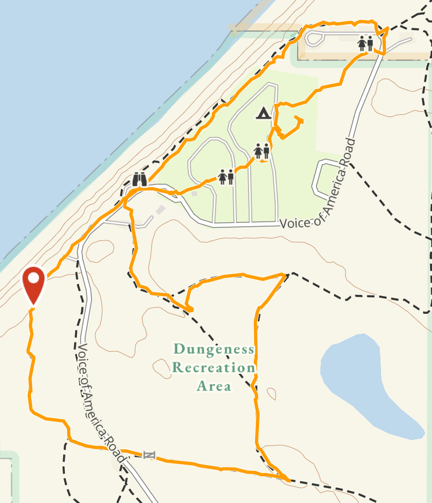
The orange line marks our hike route. You can see it on GaiaGPS, along with the one crappy photo I took.
We spent the next hour or so meandering on trails throughout the park, passing a handful of mostly masked hikers along the way. (I’m sorry, but although I do believe that masks help prevent the spread of the virus, I don’t believe they’re necessary when hiking outdoors, especially in places where the chances of passing another person are slim. I should add here that all the people I saw wearing masks along the trails were seniors so maybe they felt more at risk? I kept my distance from them.) The only wildlife I saw were squirrels, birds, and a single deer.
At one point, a woman with two medium sized dogs warned me that her dogs weren’t friendly; as if to prove her point, the two dogs strained at their leashes, growling and barking as they tried to get at my pups. To their credit, my girls hurried past them on short leashes. (Poor Lily looked absolutely terrified.) But it makes me wonder why someone wouldn’t better socialize their dogs before taking them out in public where there might be other dogs. Seriously folks: either you’re going to make your dog a part of your life and train it appropriately or you’re not. There’s very little middle ground.
One thing I noticed along the walk was that I was getting tired a lot more quickly than I should have been. The trails were relatively flat and very easy walking, yet I felt exhausted and had a headache within the first mile and a half. My left knee was aching. I definitely did not feel like hitting the road again to places unknown. I felt like taking a nap. And it wasn’t even 11 AM.
So we stopped at the pay station on the way back to camp. I filled out another envelope and stuck another $26 into it. I’d spend the day there at the park, just taking it easy, and head out the next day.
To my credit, I did hike about 2-1/4 miles that morning — basically the same walk I do three times a week with a neighbor at home.
A Lazy Afternoon
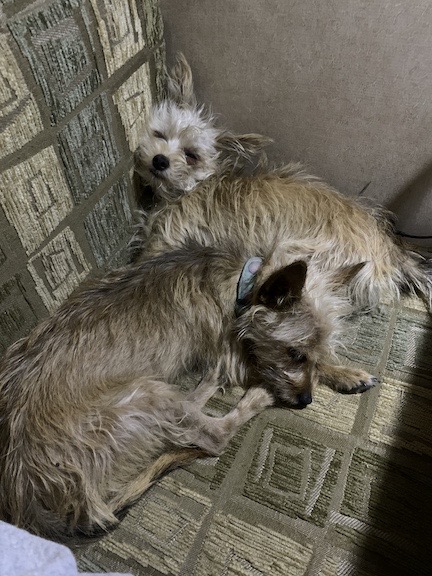
The bench seat on my RV’s dinette is small, but both pups managed to squeeze in a nap sitting next to me sometime during our stay at the park.
After a satisfactory visit to one of the campground’s coin-op showers, I reheated the previous night’s leftovers for lunch and did a little work on my blog outside at the picnic table. I tried leaving my pups off-leash at the campsite, but they invariably got “the zoomies” and chased each other out of the campsite boundaries, winding up at someone else’s site where Rosie went in for pets and Lily played keep-away. Around 2 PM, I went in for a nap with the girls. They’d skipped breakfast — sometimes they’re finicky — but wound up eating most of their food for lunch. We all climbed up on the bed together. I read for a while and then fell asleep.
I had begun wondering whether my spent feeling was due to the bad air or possible COVID exposure during my travels. I’d been with two other people, all of us maskless in a large open indoor area, all weekend. As I’ve been doing occasionally since the virus has begun spreading, I cataloged my symptoms: mild cough, mild sore throat, headache, general feeling of fatigue. I managed to get a good enough Internet connection to check the air quality in my area and saw that it was over 300: Hazardous. Maybe breathing bad air was making me sick? Whodathunkit?
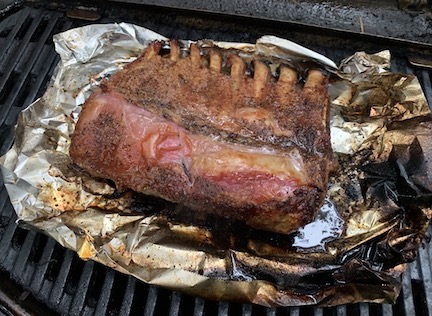
I used aluminum foil to protect the meat from the flames I knew would start up when fat hit the burners. My portable BBQ grill is very temperamental, but keeping it set to low and closing the lid gave me the ovenlike cooking I wanted.
I started dinner at 5 PM. I’d defrosted a rack of lamb and had decided to cook it on my grill instead of coating my camper’s tiny oven with spattered lamb fat. I’d never cooked rack of lamb on the grill before. I also didn’t have a meat thermometer with me. Amazingly, however, I managed to pull it off, ending up with a perfectly cooked rack that I served up with pan-fried garden potatoes and the last of my garden scallions. I had sliced figs on the side. I put half the rack in the fridge for lunch the next day.
A Feeling of Malaise
We went for two more short walks before bedtime. The nap had really helped me. I think that just taking it easy and breathing less of that bad air is what really helped me.
But I had also begun feeling as if I’d fallen into a sort of mental funk. Was I depressed? Maybe.
The situation in this country is really out of control. Between the virus and the wildfires (and their smoke) and the bullshit politics, I really don’t know how anyone can remain upbeat. There’s just too much stupidity, hate, and anger in this country these days.
I’m looking forward to a Biden presidency, but if it’s stolen from him (as it was stolen from Clinton in 2016) by foreign players and Electoral College inequities, I don’t know what I will do. I know I can’t live through four more years of what we have now but I don’t want to abandon the life I’ve built for myself and become an expat. I can’t see a compromise without putting on blinders and ignoring the damage being done to our country, its reputation in the world, and its people.
And even if Biden does win, I have worry that wacko Trump supporters — and I do mean wacko — will try to start a civil war, spurred on by Trump and Fox News. They’ve been fed a steady diet of lies about Biden and the democratic party and they honestly fear for their way of life. How can we hope to undo the damage of those lies? How can we help them see reason? I think it’s impossible.
Every day more negative stories about Trump are emerging — even stories with him on tape admitting that he misled the American people! Yet none of these stories are penetrating the thick skulls of his supporters to help them see reason. They truly are cult members. Cult members with guns who don’t think twice about ending another person’s life.
Anyway, I’ve been avoiding talking politics in my blog because, honestly, I’m sick of it. But I needed to get this off my chest, to explain the general feeling of malaise that has come over me. I think that it’s a combination of these things: COVID, smoke/fires, and politics. I suspect that if COVID and the smoke weren’t part of the big picture in my life, I’d be able to better deal with the politics. But I can’t.
[And if you’re a Trump supporter reading this, FUCK YOU. I have zero tolerance these days for people STUPID and UNPATRIOTIC enough to support the greedy, racist, narcissistic conman in the White House. I hope someday you WAKE THE FUCK UP and realize how much damage he’s done to this country. In the meantime, please leave a big, long comment on this blog post so I can have the pleasure of marking it as spam without even reading it. I want you to waste your time trying unsuccessfully to share your bullshit with my blog readers. You might want to read this if you’re worried about your First Amendment rights.]
A Peaceful, Restful Night
Sometime during the afternoon, a light rain started up. I love the sound of rain on the roof of my camper and that cheered me considerably. It was the first rain I’d experienced since June 28 and I was ready for it.
The campground was amazingly quiet; no generators, no barking dogs, no screaming kids. I think that’s what I liked most about the campground — large private sites, sparsely populated on weeknights, with very little camper noise. It gave me the illusion of staying someplace like Buck Creek Camp with the benefit of toilets, showers, and garbage receptacles.
Throughout the night, the rain came and went. Even when it wasn’t raining, I could hear big drops from the trees on top of the camper. It was like music to my ears. I slept well and woke refreshed.
The afternoon before, I’d booked a campsite at one of the coastal campgrounds in Olympic National Park. Although I had my doubts about the campground, I was able to get a site right on the ocean. It was 2-1/2 hours away. After breakfast and two dog walks, I packed up my grill, neatened up the camper, and pulled out for a leisurely drive west.
I would definitely get my walk on the beach that day.

